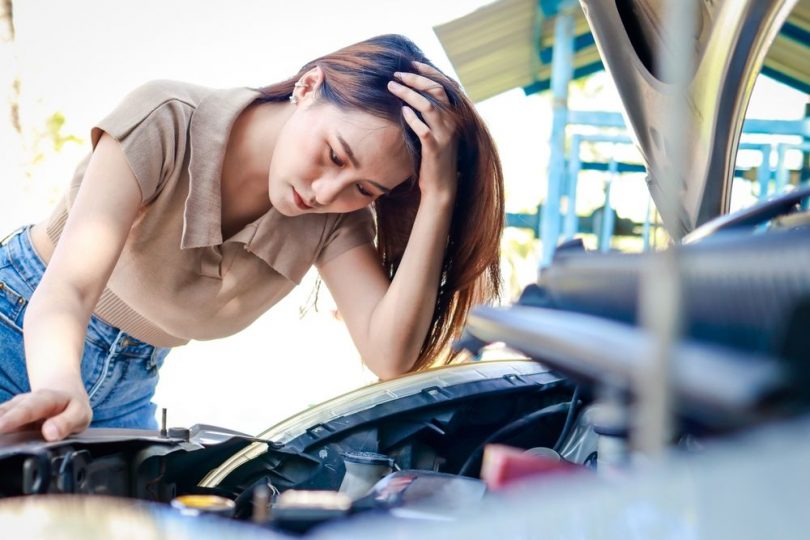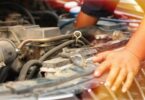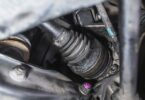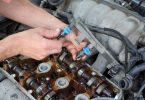You just filled your car with gas, and it won’t start. What do you do?
First, take a moment to breathe; all hope might not be lost. A vehicle won’t turn on after filling up your tank because an EVAP (Evaporative Emission Control System) valve has been left open. Other issues are a crummy battery, fuel pump, or a fuel filter clogged up.
Let’s look at why this embarrassing scenario can happen and what you can do about it if it does occur.
Why Your Car Won’t Start After Getting Gas
1. Bad EVAP purge control valve
Reason
This is the most frequent reason your vehicle won’t start up after getting gas. The EVAP purge control valve can sometimes get stuck in an open position. The EVAP helps combat gasoline vapors breaking out into the air (coming from the gas tank system) and controlling greenhouse emissions.
After fuelling your tank, the excess pressure of air needs to travel somewhere, which might be rigid with the fuel spigot. So, if it’s open, the overpressure will be pushed inside the intake manifold. An abundance of fuel will access the combustion chambers while cranking your engine. This will create a problem with your car starting.
Solution
It’s feasible to drive with a bad purge valve but not recommended since the more you drive with it, the more damage you can do to the whole EVAP system and other car parts. On top of it, you are wasting gas and sending more unnecessary emissions into the air. It’s advised to fix it yourself or go to a mechanic to repair it.
2. Defective fuel pump
Reason
Fuel pumps are located inside the fuel tank to make sure it maintains cool temperatures. If it drops too much, the pump can overheat or be damaged.
Solution
You will need to repair or replace the fuel tank. It’s probably best to have a professional mechanic do it.
3. Clogged fuel filter
Reason
The purpose of a fuel filter is to stop debris, dirt, and other contaminants from getting to the engine. It cleanses out those elements from the gas. As time goes on, these pollutants build inside the filter resulting in a blockage. This will cause your car not to start up. Poor fuel efficiency and degradation in your car’s performance are also signs of a clogged filter.
Solution
To ensure this doesn’t happen to you, be aware of the signs and change your filter regularly. It’s advised to change it from every 20 000 to 30 000 miles depending on your vehicle’s owner’s manual. It also helps to use top-of-the-line fuel in your car.
4. Bad starter
Reason
The starter does what its name implies – it turns your engine over physically and gets it to start up. It’s easy to determine if you have a bad starter because you usually hear clicking noises when turning your car key inside the ignition. Your car won’t start after getting gas because it has a damaged starter motor.
Solution
It depends on the specifics, but you most likely will need to replace your starter (which might cost around $350).
5. Dead Battery
Reason
You might be experiencing an expired or discharged battery if your car won’t start or the engine cranks gradually. It would be best if you remembered your battery’s lifespan. A regular battery last around 3 to 6 years. You will have to be extra cognizant if you have a second-hand car because, as mentioned, they don’t have a long shelf life.
Solution
Keeping up the maintenance (or replacing your battery) before it signals trouble might save you embarrassment at the pump. Avoid leaving your car lights on for long periods or running your battery until it’s empty.
Checking regularly for corrosion and cleaning it with a solution of baking soda will help tremendously and keep the connection strong.
If your car doesn’t start after getting gas, you can try boosting your car’s battery and seeing if the alternator charges greater than 12 volts. Make sure to move your car away from the pumps when you try this. This will tell you if the problem is your battery or alternator that’s causing the issue.
6. Failing alternator
Reason
The alternator charges your car’s battery while running the engine. If the alternator doesn’t work, your battery will surely die early. Sometimes people will change their battery to have the same problem happen because it might not be your battery but a failed alternator instead.
Solution
Check your alternator’s health by using a multimeter. First, with the engine off, check the car battery’s voltage. It should be between 12.5 volts to 12.8 volts. Then, with the engine on, retake the reading. It should reveal a significant increase in voltage.
If it doesn’t, it’s time for a replacement alternator.
7. Issues with spark
Reason
Spark plugs are essential because they ignite the air and fuel combination inside the car’s engine. When a spark plug becomes corrupt, the engine will misfire, and this can result in trouble starting up your motor.
Solution
To avoid issues, change your spark plugs as frequently as your car’s owner’s manual states. They have service recommendations for a reason. It’s not only the plugs that are to blame, but you will also need to think about the plug’s wiring, circuit, ignition module, and switch.
8. Not closing the cap after refueling
Reason
Not closing the cap after getting gas makes it easier for impurities into your fuel tank. This causes your engine to misfire or not start at all.
Solution
Always concentrate on what you are doing at the gas pump. You need to close the cap after refueling for a reason.
9. Jumped or skipped timing belt
Reason
Like many other parts, the timing belt will experience wear and tear over a period. Other issues with the belt include excessive mileage or an abundance of oil saturation.
Air leaks can happen when a depleted belt skips a cog or more. This will lead to lousy combustion (even non-existent).
The worst of it is a timing belt that is lacking can cause terrible engine damage where the whole power mill will need replacing.
Solution
You can investigate the belt or chain’s condition by taking off the timing cover. It must be said that mechanical skill is required to replace a timing belt. You (or a professional mechanic) will have to do many things like – a leak-down test, looking at the pistons/valves with a tool called a borescope, and examining compression power. Those things are considered the easy part of the job. The more complex part is to place the timing belt back correctly.
10. Faulty security system
Reason
It depends on your car, but it might have a security/anti-theft system with an engine immobilizer. If defective, it might debilitate your vehicle’s ignition or fuel system. You might get a security warning on your dashboard to guide you in the right direction.
Solution
Try doing a scan to diagnose precise trouble codes to find out what’s wrong. Checking out your vehicle’s owner’s manual for this will help immensely. However, security problems like this cannot be settled if you don’t have the right equipment. Contacting your car dealership is a sound choice if that’s the case.
11. Wheel lock
Reason
Wheel lock is an anti-theft/security feature that stops your car from starting (after getting gas). If this feature gets stuck in the locked position, you won’t be able to start your car or even turn your key in the ignition.
Solution
The great thing about this problem is that it is straightforward to fix. While sitting in your vehicle, push the wheel side-to-side as you turn your key in the ignition. This will undo the locked position of the wheel, enabling you to start your car.
12. Ethanol blended gas
Reason
Many countries use gas that has ethanol blended into it because it raises the octane number.
Solution
If all else fails and you have tried countless things to stop the stalling of your car, use pure gasoline in the vehicle only. This is what it might have needed all along. This is especially true if you have a high-performance balanced car. They don’t seem to like fuel that is ethanol-blended.
13. Engine flooded with gas
Reason
It doesn’t happen often, but an engine getting flooded with gas does happen with modern cars. When your engine gets flooded, it means there is a plethora of gas instead of air, which causes the vehicle not to start up.
Solution
Try opening the hood while you are cranking up the car. When you first try it, press on the gas pedal while cranking it. If that doesn’t work, try the procedure again, but don’t press the pedal this time. Also, don’t crank it for longer than 40 seconds because it can kill your battery.
14. Fuel pump-priming
Reason
Believe it or not, there is a right way to start your car, which means not rushing the procedure. Turn your key towards the ignition side of the car and wait around 10 seconds before cranking it. You might hear a buzzing noise that the fuel pump is priming the fuel’s system. Let it do its thing before cranking up the engine.
Solution
As mentioned, allow the fuel pump to achieve its job. Not allowing it to do so can result in the car not starting. The most straightforward answer is to wait so many seconds before cranking your vehicle.
15. Extremely low fuel
Reason
When you have a large amount of fuel in your tank, there is less air inside it. When there is less air, there won’t be as many things (air-related) to go wrong. Frigid air in the system can result in ice formation that can deplete fuel lines and wreak havoc with your vehicle’s drivability and performance issues.
Solution
Always keep an eye on your gas gauge. Never let your fuel get too low. The more gas in your tank, the better your car should perform.
Other things worth checking
1. Cold Injector
The cold injector is like a standard injector, except it has its control module and thermos-switch. It only is used when your car’s engine is too cold. If the module circuit or switch doesn’t work, your car won’t start up in freezing weather. You will need to look at your owner’s manual to fix it or let a mechanic do it for you if you aren’t inclined.
2. Fuse
When your vehicle is off, looking at your fuses’ wiring will determine which ones need to be replaced.
3. Ignition cylinder
The ignition cylinder will sometimes seize and not let your engine turn over. To see if this is the case, remove and test the cylinder to see if it turns over by itself. If it doesn’t, you will need to replace it. Sometimes you need to exchange the ignition cylinder and the steering column. If you have a security system, program your keys and new cylinder to the system.
4. PRNDL shifter
This will happen in automatic vehicles only. When it malfunctions due to spills or getting out of line, the car’s computer won’t recognize that it is in a neutral or parked and the car won’t start as a result.
FAQs
1. How much does it cost to replace a faulty purge valve?
Ans. It will cost around $130 to replace a defective purge valve.










Leave a Comment